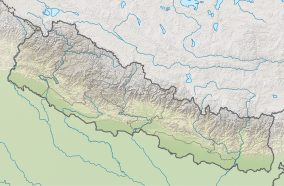| Khaptad National Park | |
|---|---|
| IUCN category II (national park) | |
 | |
| Location | Nepal |
| Coordinates | 29°16′12″N 80°59′24″E / 29.27000°N 80.99000°E / 29.27000; 80.99000 |
| Area | 225 km (87 sq mi) |
| Established | 1984 |
| Governing body | Department of National Parks and Wildlife Conservation |
Khaptad National Park is a protected area in the Far-Western Region, Nepal that was established in 1984. Stretching over the four districts of Bajhang, Bajura, Achham and Doti it covers an area of 225 km (87 sq mi) and ranges in elevation from 1,400 m (4,600 ft) to 3,300 m (10,800 ft).
History
Khaptad Baba moved to the area in the 1940s to meditate and worship. He spent about 50 years as a hermit and became a renowned spiritual saint.
Vegetation
The landscape consists of moorland, steep slopes, and streams. 567 species of flora have been recorded in the protected area. Vegetation types include chir pine-rhododendron forest, oak forest and Himalayan fir-hemlock-oak forest and alder forest in riverine areas.
Fauna

Current checklists include 23 mammals, 287 birds, and 23 amphibians and reptiles. Mammal species symbolic of the park are leopard, Himalayan black bear, wild dog, and musk deer. Bird species symbolic of the park include the impeyan pheasant, peregrine falcon, and white-rumped vulture.
Khaptad Baba Ashram
Khaptad Baba Ashram lies inside Khaptad National park. Khaptad Baba lived in Triveni located inside the national park and was known as a philosopher, physician, scientist, and astrologer.
Gallery
-
 A stream in Khaptad
A stream in Khaptad
-
 Khaptad Lagoon
Khaptad Lagoon
-
 Walking in the meadows of Khaptad
Walking in the meadows of Khaptad
-
 A view of the meadows
A view of the meadows
-
 Sunset view of meadows
Sunset view of meadows
-
 Triveni Temple after snowfall
Triveni Temple after snowfall
-
 Snow at the Triveni Temple area in Khaptad
Snow at the Triveni Temple area in Khaptad
-
 Ganga Dushera Festival in Khaptad
Ganga Dushera Festival in Khaptad
-
 The lagoon at Khaptad
The lagoon at Khaptad
-
 Wild flowers in Khaptad
Wild flowers in Khaptad
-
 Triveni Temple
Triveni Temple
-
 An older temple near the Triveni Temple
An older temple near the Triveni Temple
References
- ^ Bhuju, U. R.; Shakya, P. R.; Basnet, T. B.; Shrestha, S. (2007). Nepal Biodiversity Resource Book. Protected Areas, Ramsar Sites, and World Heritage Sites (PDF). Kathmandu: International Centre for Integrated Mountain Development, Ministry of Environment, Science and Technology, in cooperation with United Nations Environment Programme, Regional Office for Asia and the Pacific. ISBN 978-92-9115-033-5. Archived from the original (PDF) on 2011-07-26. Retrieved 2018-12-14.
- GoN/MoFSC (2014). Nepal Biodiversity Strategy and Action Plan 2014-2020. Government of Nepal, Ministry of Forests and Soil Conservation, Kathmandu, Nepal
- Joshi, L. R. (2011). "Eco-tourism Planning and Management on Eco-tourism Destinations of Bajhang District, Nepal" (PDF). Forestry Nepal, Term Paper. Archived from the original (PDF) on 2019-05-12. Retrieved 2012-12-31.
{{cite journal}}: Cite journal requires|journal=(help) - Bhatt, P. (2018). "Khaptad National Park Trek | Khaptad lake | Khaptad Baba Swami place |". Archived from the original on 2018-04-06. Retrieved 2018-04-02.
External links
- BirdLife International. "Important Bird Areas factsheet: Khaptad National Park".
- Department of National Parks and Wildlife Conservation, Nepal : Khaptad National Park Archived 2020-01-20 at the Wayback Machine
| National Parks, Reserves and Ramsar Sites of Nepal | ||
|---|---|---|
| National parks | ||
| Wildlife reserves | ||
| Conservation areas | ||
| Hunting reserves | ||
| Ramsar sites | ||



